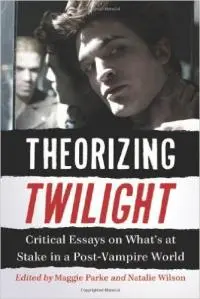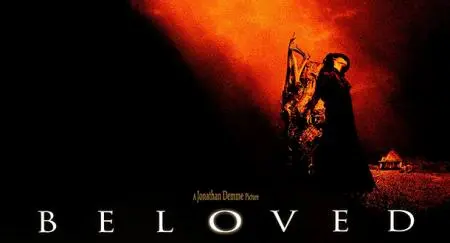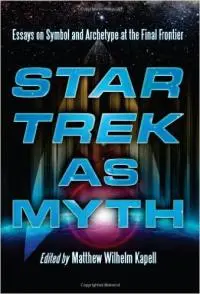Whether covering great moments in Greek architecture or the films of Tim Burton, academic essay collections tend to be released in slim paperbacks and consumed by a niche audience. That audience probably includes the authors’ peers and the college students that are either assigned readings or seek them out as sources for their writing. But it could be so much more.
Take Theorizing Twilight: Critical Essays on What’s at Stake in a Post-Vampire World. The cover manages a color still from the first Twilight movie, Robert Pattinson in all his Edwardian glory, but the inside contains only black and white stills. The layouts aren’t dynamic like a coffee table book. There’s not necessarily any big names included like a fiction anthology, a la the John Skipp and Craig Spector edited Book of the Dead featuring Stephen King, or Neil Gaiman and Jodi Picoult contributing to Last Night, a Superhero Saved My Life. And really, those two anthologies, fiction and personal essay, are what can be found on the New York Times bestseller list or on a shelf by the door at Barnes & Noble.
No, instead you get enthusiastic but seemingly impenetrable essays like “Team Bella: Fans Navigating Desire, Security, and Feminism” and “It’s a Wolf Thing: The Quileute Werewolf/Shape-Shifter Hybrid as Noble Savage.” But they’re not all deep dives, and even those that are shouldn’t be marketed as impenetrable to the layman. After all, the irony is that academic circles are more likely to treat the low brow with respect than the average People magazine, concerned only with pretty people, or Internet message boards that are inviting but shallow, focused on RPG statistics like mythology and power level.
 Academic essays can be fun to read, as well. It’s human nature to pick apart entertainment. Freshman level composition classes emphasize those skills, but they’re inherent, as evidenced by the demand for clickbait fan theories and lists of 26 reasons why everything you know is wrong.
Academic essays can be fun to read, as well. It’s human nature to pick apart entertainment. Freshman level composition classes emphasize those skills, but they’re inherent, as evidenced by the demand for clickbait fan theories and lists of 26 reasons why everything you know is wrong.
Another issue is actually getting involved with writing for anthologies. Whether fiction or non-fiction, it’s nearly impossible to get published on your own. But getting involved with an anthology means latching on to the clout the editor, or editors, already have in the publishing industry. Take, for instance, my experience with writing for three collections of essays on pop culture to be published in 2017.
About two years ago I was writing for Bleeding Cool, the comic book website, doing reviews. I reached out to my editor asking for any prospective writing opportunities. And what she introduced me to is the beauty of call for paper requests.
Now I had been familiar with call for papers before, mostly back during grad school. But it’s an overwhelming community, and hard to sift through. The best databases include the University of Pennsylvania’s CFP, and also www.cfplist.com. But mostly it’s completely random if you stumble upon a helpful CFP that’s legit, with real funding and editors with experience.
Eventually I found “What’s Eating You?”, a prospective book by Cynthia J. Miller and A. Bowdoin Van Riper. The two have worked together on several essay collections, including Undead in the West: Vampires, Zombies, Mummies and Ghosts on the Cinematic Frontier in 2012 to The Laughing Dead: The Horror-Comedy Film from Bride of Frankenstein to Zombieland released last May.
The call for papers itself usually includes a summary of the prospective collection and a list of possible topics to choose from. In the case of “What’s Eating You?” the focus is on horror movies that have an element of food and/or sustenance that play into the plot. The usual suspects would be zombies, vampires or perhaps cannibal hillbillies. Basically anything where eating is vital.
You start by submitting an abstract by e-mail. I went for an obscure choice with Beloved, the 1998 movie, starring Oprah Winfrey, Danny Glover and Thandie Newton and directed by Jonathan Demme. It didn’t get a lot of attention at the time and is all but forgotten today, but the Toni Morrison novel it’s based on is critically acclaimed, debated in academic circles and still taught in college classrooms today. This seemed the perfect culprit, though perhaps not the most accessible due to its book adaptation background and under-the-radar context as a movie.
So I submitted an abstract. It had to be 500 words long and give a good idea of the argument, the scope of the focus and possible secondary sources that would be used as research. And here, though this isn’t always the case, it had to be in AP format. And within a few weeks I got a response back.
The process has taken a little less than two years. The deadline for abstracts was May 20, 2015, the notification of acceptance was June 1, first drafts were due December 1 and final drafts were due March 1, 2016. The collection was then delivered to the publisher, Bloomsbury, in May last year and is now set to be published on February 27 this year.

That process is fairly standard, although subject to change, and always starts with a rough draft. I hadn’t read the book since grad school and had to reacquaint myself, and the movie hasn’t had any later releases than a 1999 DVD so I had to seek that out. Subsequent multiple viewings of the movie and lots of reading about the book, as the movie has received very little scholarly research, resulted in 5,000 words that approximate an argument. This was the required length, with some leeway to be 500 words shorter or longer, including the footnotes and the bibliography.
After submitting it to the editors via email, I got it back a month later with comments and suggestions in the margins. As a writer it’s always tough taking criticism, but you have to steel yourself because collaboration breeds innovation. Nothing springs from your mind fully formed and perfect, you need outside eyes and the humbling revelation that perhaps someone with more years and experience knows better.
This all sounds a little complicated, and it is. Not everyone has been to grad school and been inundated with research. But the vital takeaway here is forming relationships. Because becoming part of What’s Eating You? led to the Divine Horror anthology that will be released later this year.
It was a very similar form of call for papers, but this time the subject was writing on horror movies that have a supernatural element specifically dealing with higher powers, the afterlife and the presence of these paranormal beings on earth. Presumably this would manifest most blatantly in possession movies, like The Exorcist, or movies in which divine beings actually make an appearance on Earth, like The Prophecy or The Devil’s Advocate.
I chose to write about the Spanish found-footage horror movie [Rec] and its American remake Quarantine, discussing the religious aspects in each. Needless to say, due to the more populist appeal of these movies and the zombie subgenre this essay would be more readable for Joe Sixpack.
 Having built up a bit of a portfolio, I went looking for other call for papers. This is where experience comes in, as I had read Matthew Wilhelm Kapell’s Star Trek As Myth: Essays on Symbol and Archetype at the Final Frontier, a 2010 compilation of essays from the last 40 years on the popular franchise. That book included only one essay on the J.J. Abrams Star Trek (2009), but when I contacted Kapell on Twitter he revealed that he was pitching a new book focused entirely on the “Kelvin” timeline of the new trilogy: Star Trek, Star Trek into Darkness, and Star Trek Beyond. And since I had already written for two anthologies, I had the appropriate background now.
Having built up a bit of a portfolio, I went looking for other call for papers. This is where experience comes in, as I had read Matthew Wilhelm Kapell’s Star Trek As Myth: Essays on Symbol and Archetype at the Final Frontier, a 2010 compilation of essays from the last 40 years on the popular franchise. That book included only one essay on the J.J. Abrams Star Trek (2009), but when I contacted Kapell on Twitter he revealed that he was pitching a new book focused entirely on the “Kelvin” timeline of the new trilogy: Star Trek, Star Trek into Darkness, and Star Trek Beyond. And since I had already written for two anthologies, I had the appropriate background now.
A month or so later he emailed me the call for papers directly, but it also went up on H-Announce, a site devoted to easy access to call for papers. This time the abstract could only be 250 words, but also needed to include a 1-2 page CV, a resume including projects and publications. I decided to write about Star Trek into Darkness, the much maligned second entry in the series, and emailed my abstract out into the void. Luckily it was accepted, with a rough draft ranging between 5,000 to 6,000 words with a due date of January 10 that ended up getting pushed back to March. Much like with the horror-related essays, the process involves the editor looking it over and getting it back to me a month or so later, and then I have about a month to get it back to them. The book should be published by the end of this year, making the whole process about a year long.
When it comes to whether or not these three essay collections will be enjoyable for the average reader, the first point to vouch for is the subject matter. The average Joe on the street probably assumes that essay collections are stuffy and wholly focused on contentious subjects such as feminism or racism. The good thing about essay collections is they contain dozens of essays, so it’s not a matter of reading the book from cover to cover. And they’re not all on obscure older or foreign movies like The Seventh Seal or The 400 Blows.
So while I chose Beloved just to be different, many other writers in What’s Eating You? went with familiar movies that have been popular with a broad audience. There’s Shaun of the Dead, of course, and other comedies such as Poultrygeist, and musicals with a tinge of comedy like Sweeney Todd.
And what this shows is that academic essay collections have the unique role of putting the magnifying glass over movies that usually don’t get much attention or are dismissed outright. Horror movies and comedies rarely get nominated for prestige awards, and are generally viewed as disposable and not deserving of categorization as art. Musicals, similarly, have ebbs and flows where they fall out of favor with the mainstream. But by being on the fringe the creators have the freedom to experiment and explore taboo subject matter, and that makes them exciting for the academic. The same is true of the horror and divine book that explores movies that are usually dismissed as shock value, especially with The Exorcist’s emphasis on a young girl cursing and abusing herself.
Academic essays can be intimidating at first, both to write and get published and to read. But like most things in life, getting your 5,000+ word essay in a book is a matter of hard work, building up a portfolio and, most importantly, relationships. Reading said published essays, however, is a matter of realizing they’re not as impenetrable as the first impression. Although these books appear on the surface to be aimed only at college professors and their reluctant students, the subject matter has the potential for such vast and broad subjects—everything from high brow to low brow—that one is bound to find something that intrigues them.
Just keep a dictionary handy while reading, and watch out for words like "semiotic."

About the author
A professor once told Bart Bishop that all literature is about "sex, death and religion," tainting his mind forever. A Master's in English later, he teaches college writing and tells his students the same thing, constantly, much to their chagrin. He’s also edited two published novels and loves overthinking movies, books, the theater and fiction in all forms at such varied spots as CHUD, Bleeding Cool, CityBeat and Cincinnati Magazine. He lives in Cincinnati, Ohio with his wife and daughter.







